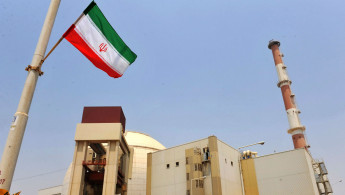Explainer: The landmark 2015 Iran nuclear deal
It was a breakthrough that ended a 12-year standoff between Iran and the West, concerned Tehran was developing a nuclear bomb.
On Tuesday, US President Donald Trump is due to announce his verdict on the sanctions relief underpinning the accord, which he insists was "very badly negotiated".
Here is some background on the landmark deal.
21 months of talks
Negotiations start in June 2013 between Iran and the five permanent members of the UN Security Council - the UK, China, France, Russia and the United States - plus Germany.
By November they reach an interim deal that is finalised in April 2015 and signed on 14 July that year.
Twitter Post
|
The UN Security Council adopts the deal on 20 July 2015 and it comes into force on 16 January 2016.
Key points
The accord brings to a minimum of one year, for at least ten years, the "breakout time" that Iran needs to produce enough fissile material to make an atom bomb.
Among other points, Tehran agrees to slash the number of centrifuges, which can enrich uranium for nuclear fuel as well as for nuclear weapons, from more than 19,000 to 5,060, maintaining this level for a decade.
The deal limits all enrichment to only one facility.
It also stipulates that Iran's pre-deal stockpile of 12 tonnes of low-enriched uranium - enough for several nuclear weapons if further enriched - must be reduced to 300 kilogrammes for 15 years.
Only enrichment to low purities is allowed, also for 15 years.
Controls
The International Atomic Energy Agency (IAEA) is charged with regular inspections of facilities such as uranium mines and centrifuge workshops for up to 25 years.
UN inspectors have certified Iran's compliance with the deal nine times, most recently in November.
Sanctions eased
The accord paved the way for a partial lifting of international sanctions on Iran, opening the door for foreign investors with French energy giant Total and carmakers PSA and Renault quick to strike deals.
UN embargoes on the sale of conventional arms and on ballistic missiles to Iran have, however, been maintained up to 2020 and 2023 respectively.
12 May ultimatum
In October 2017, Trump refuses to certify that Iran is respecting its commitments on the agreement but he does not re-impose sanctions or abandon the deal itself.
Trump again waives sanctions in January but he demands that European partners "fix the terrible flaws" in the accord before 12 May, the next decision deadline for Trump on the deal.
Ahead of the deadline the US leader says he will announce his decision Tuesday, putting an abrupt end to efforts over the past weeks by the UK, Germany and France to save the deal.
"If the United States leaves the nuclear agreement, you will soon see that they will regret it like never before in history," Iranian President Hassan Rouhani says on Sunday.





 Follow the Middle East's top stories in English at The New Arab on Google News
Follow the Middle East's top stories in English at The New Arab on Google News
![Both Hamas and the Palestinian Authority welcomed the ICC arrest warrants [Getty]](/sites/default/files/styles/image_330x185/public/2024-11/GettyImages-2178351173.jpg?h=199d8c1f&itok=TV858iVg)

